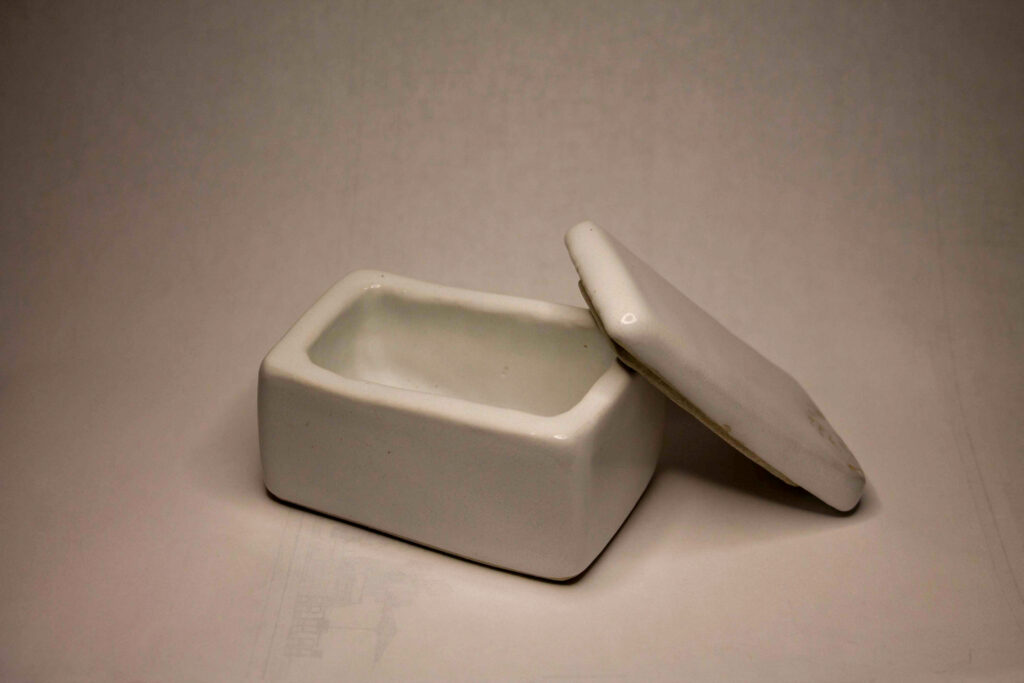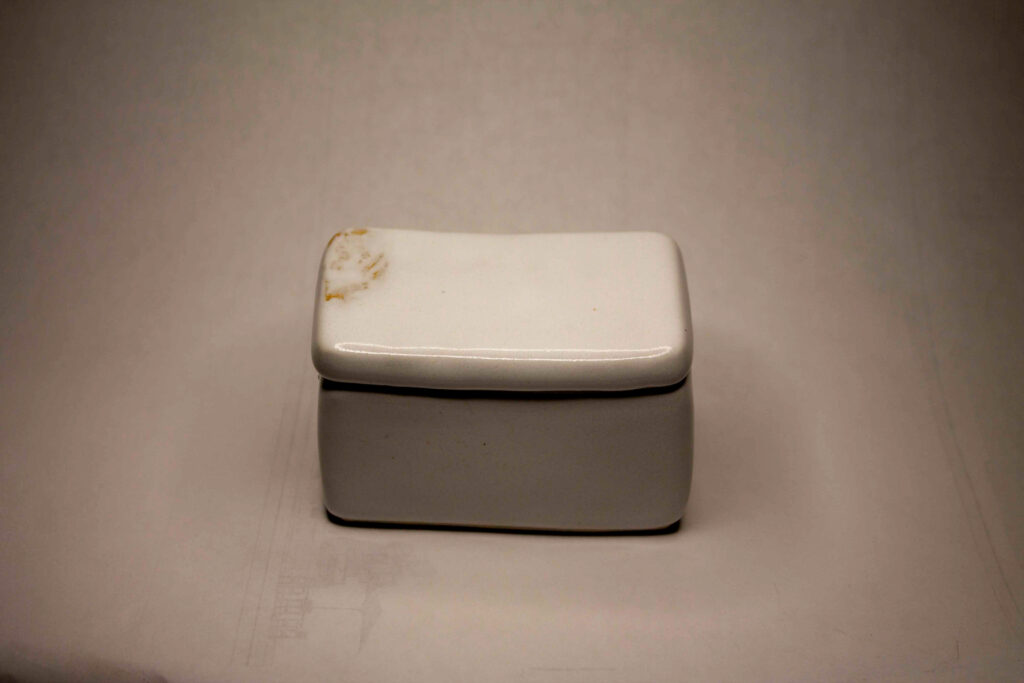Unveiling Function and Form
Our everyday lives are filled with objects that meld functionality with aesthetic simplicity. This ceramic box is a testament to such a blend, embracing a minimalist design that speaks volumes through its understated elegance. The rectangular form, with its clean lines and smooth surfaces, evokes a sense of serenity and order.

Craftsmanship in Detail
The craftsmanship of the box is highlighted by its flawless finish. A gentle curve softens the transition between the lid and the base, offering a tactile experience that invites touch. The choice of a matte, creamy glaze contributes to its tranquil presence, while a subtle interplay of shadow and light dances across its surfaces, revealing the box’s delicate contours.

A Closer Look Inside
The lid lifts to reveal a hollow interior, the space within as thoughtfully crafted as the exterior. This inner sanctum holds potential; it is a keeper of treasures, a guardian of personal artifacts. The slight imperfection inside, where the glaze has pooled and crystallized, tells of the box’s unique journey through the kiln – a singular moment frozen in time.

Function Meets Form
Displayed with the lid ajar, the box transforms, its open mouth presenting a new dimension of utility. Whether it serves as a container for precious items or stands alone as a sculptural piece, it maintains a balance between use and beauty. The way the lid rests upon the base suggests an inviting gesture, as if prompting the onlooker to discover what lies within.

Mastery Through Kurinuki: The Technique Behind the Box
Kurinuki, a traditional Japanese method of hand-forming pottery, is characterized by its ‘carving out’ process. Unlike pottery thrown on a wheel or built with coils, kurinuki starts with a solid block of clay. This technique calls for patience and precision, as the artist gradually hollows out the material, shaping its final form from the inside out.
The Kurinuki Process
The creation of this ceramic box began with a solid mass of clay. The artist’s hands delved into the core, meticulously scooping out clay to form an inner cavity. This subtractive process is meditative, requiring a contemplative approach as the artist removes just enough clay to achieve the desired wall thickness, all while maintaining the structural integrity of the piece.

Shaping and Refinement
Once the basic inner form was established, the outer shape began to take form. The artist shaped the exterior, carefully curving and smoothing the walls to manifest the envisioned design. With kurinuki, the artist must think in three dimensions, simultaneously considering the interior and exterior contours.
Surface and Texture
As the box took shape, the surface was smoothed to prepare for the glazing process. However, the kurinuki technique often leaves subtle textures – traces of the artist’s movements and tools that carved the clay. These textures were embraced, giving the box its unique tactile quality and visual interest.
Firing and Finishing
After drying, the box was bisque-fired, a step that hardens the clay and prepares it for glazing. The chosen glaze was applied, a decision that influences the final aesthetic and feel of the piece. The high firing in the kiln not only solidified the glaze but also brought out subtle details, such as the crystallization within the interior – a beautiful byproduct of the kurinuki method and the chemical reactions during the firing.
The Personal Touch of Kurinuki
Kurinuki is more than a technique; it is a personal journey between the artist and the clay. This ceramic box, with its minimalist charm, is a product of
time-honored methods fused with the artist’s intimate touch. Each angle, curve, and line speaks to the hours of hands-on labor, the careful removal of clay, and the attentive smoothing of surfaces. This piece is not just molded by hands, but also by the spirit and philosophy embedded within the kurinuki tradition.

Embracing Imperfection
In line with the wabi-sabi aesthetic often associated with kurinuki, this box celebrates the beauty of imperfection. The slight irregularities and variations in thickness are not flaws, but rather marks of authenticity and the handmade process. They tell a story of creation that machines and mass production cannot replicate.
Unity of Form and Function
The box, in its completed state, is a testament to the kurinuki technique’s ability to produce works that are both functional and artistic. It stands as a reminder of the slow and reflective nature of traditional craftsmanship, inviting us to appreciate the deeper values of patience, attention to detail, and respect for the raw materials from which it came.
In this ceramic box, kurinuki has given rise to a piece that is not only a container of objects but also a vessel of cultural heritage and artistic dedication. Through this technique, the artist connects with the past, engages with the present, and creates a legacy that will endure well into the future.






